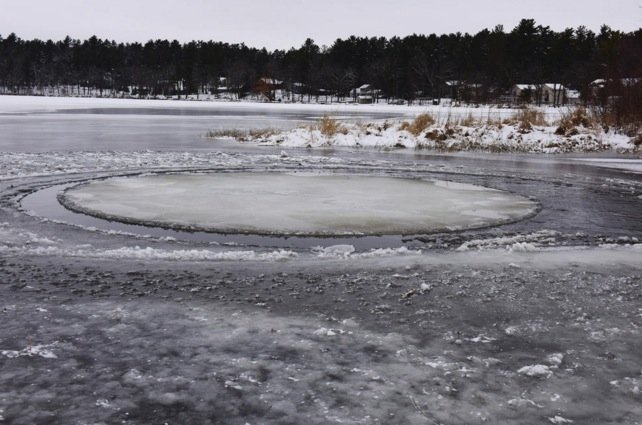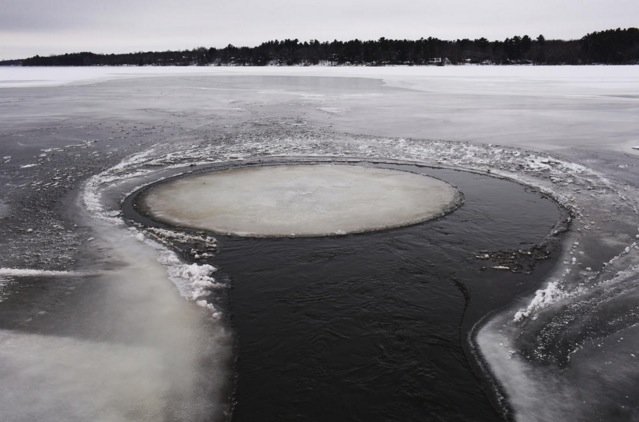
"So you get ice forming and it gets bigger as it gets colder and then the water that is moving faster is not freezing up, so what you get in the end is this big pancake of ice that is moving slowly around in a circle," said Peter Boulay, DNR climatologist. "You see pancake ice on water that's moving. When the lakes are trying to freeze up this past weekend, I saw a lot of that kind of ice forming in circles. "It's a sign of turbulent water and some stillness in the water in the middle."
Nearby residents were stopping to see the rotating ice circle after word about it was passed via Facebook, from the lake association and between neighbors. "It's amazing," said Upper South Long Lake resident Karen Reil.
Sue Rolfs, who has been an Upper South Long Lake resident since 1957, said she's never seen the phenomenon before. Residents who have lived on the lake for 25 years or more echoed that sentiment. Monday they were drawn to the water to watch the perfect circle swirl in the black water at the inlet.
"We've all been coming and watching it," Marlene Kossila. "It's neat to watch." Kossila said the residents have been coming to watch the ice not knowing when the phenomenon will end. "It's getting smaller or the opening around it is getting smaller," she said of the ice circle.
A spinning ice circle was reported on the Sheyenne River in North Dakota in 2013, at which time it was noted such icy discs have been seen in Canada, England and Sweden. Bill Kronstedt said after years of living in the area this pattern, this perfect circle, was a new experience. "You've got to wonder how long it's going to be here," Kronstedt said. "It's kinda cool. It is definitely neat."
Winter weather
Boulay said this start of the winter season is on track to be one of the top five warmest on record for November and December. Many lakes have yet to fully form ice with late ice-in records likely to be shattered this December. There isn't a robust database for ice-ins compared to highly anticipated ice-outs in the spring, but this year may rival records set on area lakes including the latests ice-in on record of Dec. 22, 1998, on Gull Lake.
"We are going up against the latest we've ever seen for these lakes," Boulay said. "It is very late and it's more magnified because we had two relatively early ice-ins the last two years. We are a month later than last year in general."
On the negative side, this warmer weather—while not producing the frozen pipes and septic systems of the last two harsh winters—is reducing time people could have been out ice fishing, Boulay said. The odd ice and late ice formation may serve as a reminder that ice can be tricky on the best of years and should always be treated with healthy skepticism.
"That's always our message, use extreme caution in any case and this year especially maybe more than other years because we have not had the cold weather to really make good ice," Boulay said.
There is cold air around it just isn't in Minnesota. Fairbanks, Alaska, as a comparison, has had a colder than normal December. Boulay said the cold air is bottled far to the north and so far lacks a conduit to reach Minnesota. The Climate Prediction Center's outlook indicates there will be a warmer than normal January, February and March to start the new year.
"It's an El Nino pattern basically the polar jet stays way up in Canada and we kind of stay on the mild side," Boulay said. There are storms around, but they have to be able to tap into cold air to make a difference for winter storms or traditional weather, Boulay said. "It looks as if El Nino is definitely in control of our weather this winter so far."
Even snow is in short supply across the state. While central Minnesota will have a white Christmas, the snow line ends to the south. And the Twin Cities is preparing for a snowless Christmas, which can't be characterized as a brown one.
"It's like we are having a green Christmas," Boulay said. "It's strange."




Comment: Huge ice circle forms in Swedish river